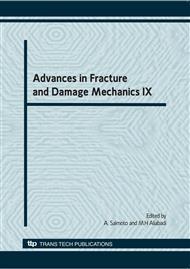[1]
E. Schlangen and J.G.M. van Mier, Experimental and Numerical Analysis of Micromechanisms of Fracture of Cement-based Composites, Cement and Concrete Composites, 14, 105-118 (1992).
DOI: 10.1016/0958-9465(92)90004-f
Google Scholar
[2]
E. Schlangen and Z. Qian, 3D Modeling of Fracture in Cement-based Materials, Journal of Multiscale Modelling, 1(2), 245-261 (2009).
DOI: 10.1142/s1756973709000116
Google Scholar
[3]
E.J. Garboczi, Three-dimensional Mathematical Analysis of Particle Shape using X-ray Tomography and Spherical Harmonics: Application to Aggregates used in Concrete, Cement and Concrete Research, 32, 1621-1638 (2002).
DOI: 10.1016/s0008-8846(02)00836-0
Google Scholar
[4]
K. van Breugel, Simulation of Hydration and Formation of Structure in Hardening Cementbased Materials, PhD Thesis (2nd Edition), Delft University of Technology, Delft (1997).
Google Scholar
[5]
D. Bentz, CEMHYD3D: A Three-Dimensional Cement Hydration and Microstructure Development Modeling Package (Version 3. 0), National Institute of Standards and Technology Interagency Report, Technology Administration, U.S. Department of Commerce, NISTIR 7232, June (2005).
DOI: 10.6028/nist.ir.7232
Google Scholar
[6]
S. Bishnoi and K.L. Scrivener, µic: A New Platform for Modelling the Hydration of Cements, Cement and Concrete Research, 39(4), 266-274 (2009).
DOI: 10.1016/j.cemconres.2008.12.002
Google Scholar
[7]
E. Schlangen, Experimental and Numerical Analysis of Fracture Processes in Concrete, PhD Thesis, Delft University of Technology, Delft (1993).
Google Scholar
[8]
H. Manzano, J.S. Dolado and A. Ayuela, Elastic Properties of the Main Species present in Portland Cement Pastes, Acta Materialia, 57, 1666-1674 (2009).
DOI: 10.1016/j.actamat.2008.12.007
Google Scholar
[9]
J. Sanahuja, L. Dormieux and G. Chanvillard, Modelling Elasticity of a Hydrating Cement Paste, Cement and Concrete Research, 37, 1427-1439 (2007).
DOI: 10.1016/j.cemconres.2007.07.003
Google Scholar


